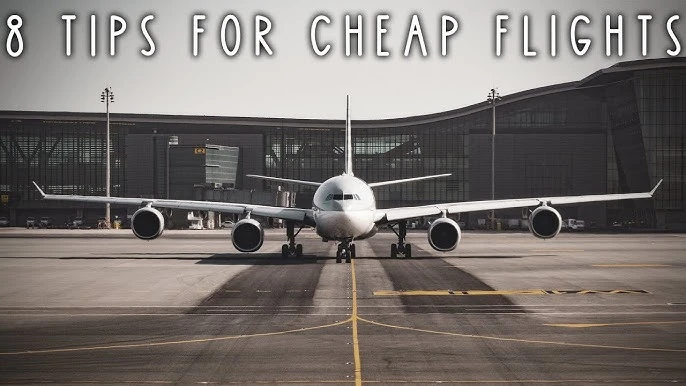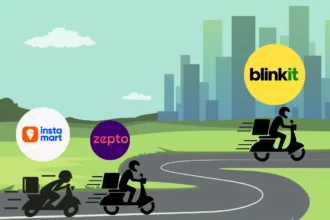Estimated Reading Time: 22-28 minutes ( 4,511 words)
Introduction
In 2025, booking a cheap flight isn’t just about luck, clearing cookies, or hunting for last-minute deals — it’s about understanding the AI algorithms quietly deciding what you pay. Airlines across the world now rely on dynamic pricing engines that analyze billions of data points every hour — from seat availability and search volume to your device type and even browsing history. These invisible systems are designed to squeeze maximum revenue per seat, which is why your fare can jump within minutes, even for the same route and time.
What this means for travelers is simple but game-changing: the “cheapest fare” is no longer fixed — it’s fluid, adaptive, and often tailored to your behavior. One traveler might see ₹6,499 for a Delhi–Goa ticket, while another, searching moments later on a different device, might see ₹7,200. The rules of flight booking have evolved from luck-based to data-driven, where small actions — timing your searches, using VPNs, picking alternate airports, or choosing smarter payment methods — can help you save thousands every year.
Whether you’re an Indian student booking a Europe trip, a digital nomad hopping across Asia, or a family planning a budget getaway, mastering these insider travel hacks gives you a real advantage. This blog breaks down how to get the cheapest flight tickets in today’s algorithmic world — using verified data, real-world examples, and expert-approved tools. By the end, you’ll know exactly when, where, and how to book flights at the lowest prices — without falling for myths or gimmicks.

How Airline Pricing Really Works (2025 Update)
Airline ticket prices aren’t random — they’re set by complex revenue management algorithms powered by AI, demand forecasting, and behavioral data.
Here’s what really drives the price you see 👇
✈️ Key Factors Influencing Flight Prices
- Demand Spikes & Search Volume:
When more people search for the same route — for example, Delhi–Goa before a long weekend — airlines interpret it as rising demand.
Their algorithm automatically raises fares to maximize profit. - Remaining Inventory:
Airlines divide seats into multiple “fare buckets.”
As cheaper fare buckets sell out, prices jump to the next level.
That’s why waiting just a few hours can mean paying 20–40% more. - User Behavior & Cookies:
Your browsing history, login status, and repeated searches can signal purchase intent.
Dynamic pricing tools may increase fares slightly for frequent searchers to push faster decisions — a strategy known as personalized pricing. - Competitor Price Tracking:
Airlines constantly monitor competitors.
If IndiGo lowers fares on Mumbai–Bengaluru, SpiceJet or Akasa may follow within hours to stay competitive.
Conversely, if one carrier’s flight starts filling up, others may raise their rates too. - Booking Timing (Seasonality & Weekday Impact):
Midweek flights (Tuesday/Wednesday) are usually cheaper, while weekend or holiday flights surge.
Booking 45–60 days in advance is the sweet spot for most routes. - Origin & Destination Pairing:
Prices depend on market demand in both directions.
A Delhi–Bangkok route might be cheaper than Bangkok–Delhi on the same day, depending on outbound vs. inbound travel data. - Currency, Taxes & Fuel Prices:
Exchange rate fluctuations and aviation turbine fuel (ATF) costs directly impact ticket prices, especially for international routes. - Payment & Location-Based Pricing:
Airlines show different prices depending on your country, IP address, and payment method.
Sometimes using a VPN to simulate another location can reveal cheaper fares.
📊 Stat to Know
- According to the International Air Transport Association (IATA, 2025):
- Global air traffic grew 10.4% in 2024, surpassing pre-pandemic levels.
- Average airfares rose by 18–22% (2022–2024) due to dynamic pricing, fuel cost volatility, and increased travel demand.
(Source: IATA Annual Report 2025)
- Global air traffic grew 10.4% in 2024, surpassing pre-pandemic levels.
💡 Quick Insight
👉 The same seat can cost ₹6,000 in the morning and ₹9,500 by night — all because of demand shifts, seat inventory, and user behavior triggers.
Global & India Travel Trends You Must Know (2025 Edition)
The global air travel landscape in 2025 is more competitive, data-driven, and digitally integrated than ever before.
India has emerged as one of the fastest-growing aviation markets, shaping global airfare trends and traveler behavior.
Here’s a breakdown of the most important shifts every traveler should know 👇
✈️ 1. India’s Air Travel Boom: The New Global Powerhouse
- India officially became the 5th largest aviation market in 2024, with over 240 million passengers traveling by air.
- Low-cost carriers (LCCs) dominate the scene — IndiGo controls ~60% of the domestic market, followed by Air India, Akasa Air, and SpiceJet.
- The government’s UDAN scheme (Ude Desh ka Aam Nagrik) and new regional airports are further boosting Tier-2 and Tier-3 connectivity.
- With this growth, India’s airfare pricing has become more algorithmically dynamic, and LCCs now have major influence on fare trends.
(Sources: DGCA India, CAPA India, Economic Times 2025)
🌏 2. Domestic Wins, International Challenges
- Domestic routes such as Delhi–Bengaluru, Mumbai–Goa, and Hyderabad–Kolkata have largely stabilised post-pandemic, thanks to capacity expansion and competition.
- However, international fares remain volatile, especially on India–UAE, India–US, and India–UK routes due to limited slots, fuel costs, and currency fluctuations.
- Airlines frequently use dynamic fare recalibration, adjusting prices multiple times per day based on booking velocity.
- Travelers planning long-haul routes should track fares 8–12 weeks in advance to avoid surge pricing.
(Sources: IATA, OAG Aviation Analytics, Skyscanner 2025)
💺 3. Hidden Costs: The Rise of Ancillary Revenues
- The so-called “cheap ticket” may no longer be truly cheap.
- Global ancillary revenue — from baggage, seat selection, meals, and priority boarding — hit a record $148 billion in 2024, up 23% YoY.
- Low-cost carriers now earn 40% or more of their profits from add-ons rather than base fares.
- Smart travelers should always compare total trip cost, not just the base fare, to avoid surprise expenses.
(Sources: IdeaWorksCompany, Statista Aviation Reports 2025)
💳 4. UPI, Credit Cards & BNPL Redefine Travel Payments
- India is leading a quiet revolution in digital travel payments.
- As of early 2025, over 35% of flight bookings in India are completed using UPI, credit/debit cards, or BNPL (Buy Now, Pay Later) options.
- Platforms like MakeMyTrip, Cleartrip, Ixigo, and EaseMyTrip partner with fintech players like Paytm, PhonePe, and Simpl to offer cashback, rewards, and EMI offers.
- UPI-linked credit and travel wallets (like HDFC’s SmartBuy and Axis Grab Deals) make it easier to stack discounts and reduce real ticket costs.
(Sources: NPCI, ET Travel, Statista Fintech Reports 2025)
🤖 5. AI-Driven Fare Predictors & Smart Booking Tools
- Tools such as Google Flights, Skyscanner, Hopper, and Kayak now use machine learning to analyze millions of fare patterns daily.
- These AI systems predict whether prices are likely to rise or fall — helping travelers decide when to book.
- For instance, Skyscanner’s 2025 report shows users save up to 27% on average when following AI recommendations.
- Many Indian OTAs are integrating similar AI models to personalize alerts and bundle hotel + flight deals dynamically.
(Sources: Skyscanner Insights 2025, Hopper AI Report, Google Travel Data)
📈 6. Sustainability & Carbon-Smart Travel (Bonus Trend)
- Globally, travelers are showing growing interest in eco-friendly flights — airlines like Vistara and Emirates now display CO₂ impact scores at checkout.
- Carbon-neutral initiatives and SAF (Sustainable Aviation Fuel) programs are influencing route planning and pricing.
- Expect a small “green premium” on select international flights by 2026–27.
(Sources: IATA Sustainability Report 2025)
📊 Quick Insight Box
- 🧳 Total Indian passengers (2024): 240 million+
- 💸 Average global airfare increase (2022–24): +18–22%
- 💰 Global ancillary revenue: $148 billion
- 📱 Indian bookings using digital payments: 35%+
- 🤖 AI tools’ average savings: 20–30%
(Sources: IATA, DGCA India, NPCI, Statista, Skyscanner 2025)
15 Insider Tips to Get the Cheapest Flight Tickets (2025 Edition)
Flight prices may seem unpredictable — but they follow patterns. By combining data-backed timing, tech tricks, and India-specific hacks, you can consistently save 25–60% on airfares without compromising comfort.
Below are 15 proven insider strategies — divided into four key categories — based on insights from Skyscanner, IATA, DGCA India, and real traveler data (2025).
🕐 A. Smart Timing & Booking Windows
- 📅 Book 6–8 Weeks in Advance (Domestic) & 10–12 Weeks (International)
- Research from Google Flights and Hopper (2025) shows most routes hit their lowest prices in this window.
- For Indian flyers: domestic sweet spot = 45–55 days; international = 70–90 days.
- Avoid booking more than 5 months ahead — early fares are often higher as airlines test demand.
- Research from Google Flights and Hopper (2025) shows most routes hit their lowest prices in this window.
- 🛫 Fly Midweek or Off-Peak
- Tuesdays and Wednesdays are statistically 20–30% cheaper than Fridays or Sundays.
- Avoid business-heavy morning slots (6–9 a.m.) and fly during late nights or noon hours for cheaper seats.
- Example: A Mumbai–Delhi ticket on a Tuesday noon flight may cost ₹4,800 vs ₹6,200 on a Friday evening.
- Tuesdays and Wednesdays are statistically 20–30% cheaper than Fridays or Sundays.
- 🎉 Avoid Festival or Long-Weekend Rush (India-Specific)
- During Diwali, Holi, Independence Day, and Christmas, fares can double or even triple.
- Use flexible date search tools (on Skyscanner or Google Flights) to identify pre/post-holiday cheaper windows.
- Pro tip: flying one day before or after peak dates can save 25–40%.
- During Diwali, Holi, Independence Day, and Christmas, fares can double or even triple.
- 🔔 Set Automated Fare Alerts
- Tools like Skyscanner, Kayak, and Google Flights allow you to track specific routes and notify you instantly when prices drop.
- Travelers who set alerts save up to 23% on average compared to those who don’t track fares.
- Combine with “Track Prices” features in Gmail (for flight confirmation emails).
- Tools like Skyscanner, Kayak, and Google Flights allow you to track specific routes and notify you instantly when prices drop.
💻 B. Tech & Browser Hacks
- 🕶️ Search in Incognito Mode / Clear Cache Regularly
- Airlines and OTAs may adjust prices if they detect repeated searches from the same IP.
- Always search in incognito/private mode or use a different browser/device to see unbiased results.
- You can also use VPNs to simulate new users for more neutral pricing.
- Airlines and OTAs may adjust prices if they detect repeated searches from the same IP.
- 🧭 Compare Across Platforms (Meta Search + Airline Direct)
- Some airlines — especially under the New Distribution Capability (NDC) model — offer exclusive low fares on their own sites.
- Always cross-check between Google Flights, Skyscanner, and airline websites before finalizing.
- Example: IndiGo and Air India frequently list cheaper fares on their portals than on MakeMyTrip or Goibibo.
- Some airlines — especially under the New Distribution Capability (NDC) model — offer exclusive low fares on their own sites.
- 🌍 Try “Hidden City” & Multi-City Route Tricks
- Sometimes, booking a longer route with a layover is cheaper than a direct flight.
- Example: Mumbai–Doha–Istanbul might be ₹8,000 cheaper than Mumbai–Istanbul direct.
- Use with caution — avoid checked baggage, as the final destination may differ from your intended stop.
- Sometimes, booking a longer route with a layover is cheaper than a direct flight.
- 🌐 Use VPNs to Check Regional Price Differences
- Ticket prices vary by country due to currency, local taxes, and promotional offers.
- Use VPN servers set to countries like Malaysia, UAE, or Singapore to compare fares.
- Example: A Delhi–Bangkok fare may be ₹2,000 cheaper when booked via Thai or Singapore-based portals.
- Ticket prices vary by country due to currency, local taxes, and promotional offers.
- 📊 Leverage the Right Flight Comparison Tools
- 🕵️♂️ Best for alerts: Google Flights, Skyscanner
- 🇮🇳 Best for Indian routes: Ixigo, Cleartrip, EaseMyTrip
- 🌎 Best for international search: Momondo, Kayak
- ✈️ Combine them for multi-site fare triangulation — ideal for price benchmarking before purchase.
- 🕵️♂️ Best for alerts: Google Flights, Skyscanner
💳 C. Airline Loyalty, Cards & Cashbacks
- 💳 Use Credit Cards with Travel Perks & Partner Portals
- Cards like HDFC Diners Club Privilege, Axis Atlas, SBI Cashback, and Amex Platinum Travel offer 5–10% instant cashback or miles.
- Always check if your card has tie-ups with OTAs like MakeMyTrip, Yatra, or airline portals (Air India, Vistara).
- Some premium cards also include lounge access and travel insurance, adding hidden value.
- Cards like HDFC Diners Club Privilege, Axis Atlas, SBI Cashback, and Amex Platinum Travel offer 5–10% instant cashback or miles.
- 🌟 Join Airline Loyalty Programs (Even if You Fly Occasionally)
- Programs like Air India Flying Returns, Vistara Club Vistara, and IndiGo 6E Rewards accumulate miles that offset baggage fees or upgrades.
- Use alliance networks such as Star Alliance or OneWorld to pool miles across multiple carriers.
- Even 2–3 trips a year can yield tangible savings over time.
- Programs like Air India Flying Returns, Vistara Club Vistara, and IndiGo 6E Rewards accumulate miles that offset baggage fees or upgrades.
- 🎯 Redeem Reward Points Smartly
- Always calculate the rupee value per point — sometimes redeeming points for flight vouchers offers 2× better value than merchandise.
- Booking through airline portals often yields the best redemption conversion (₹0.50–₹0.80 per point).
- Check if your bank allows “Instant Redemption” during flight booking.
- Always calculate the rupee value per point — sometimes redeeming points for flight vouchers offers 2× better value than merchandise.
- 💰 Stack Offers (UPI + Wallet + Card)
- Combine multiple payment layers for maximum discounts.
- Example: ₹200 Paytm cashback + 10% HDFC SmartBuy discount + airline promo code.
- Some OTAs allow split payments between UPI, wallet, and card — optimize every layer.
- Combine multiple payment layers for maximum discounts.
🇮🇳 D. India-Specific Booking Tactics
- 🌐 Book via Indian OTAs with Local Flash Deals
- Indian platforms like EaseMyTrip, Ixigo, Yatra, Goibibo, and Paytm Travel regularly host “India-only” limited-time offers unavailable on international portals.
- EaseMyTrip often provides “zero convenience fee” campaigns, while Ixigo and Yatra offer wallet cashback.
- Sign up for email alerts and app notifications to grab midnight flash sales.
- Indian platforms like EaseMyTrip, Ixigo, Yatra, Goibibo, and Paytm Travel regularly host “India-only” limited-time offers unavailable on international portals.
- ✈️ Leverage Airline Passes, Subscriptions & Bundles
- Airlines like IndiGo (6E Prime), Akasa Air, and Air India now offer bundled passes for frequent domestic travelers.
- Benefits include zero change fees, free seat selection, and 25–40% savings on multi-trip packages.
- Ideal for business travelers, content creators, and weekend flyers who travel frequently.
- Check ongoing offers like 6E Rewards, 6E Prime Flex, and Akasa Air Flight Pass.
- Airlines like IndiGo (6E Prime), Akasa Air, and Air India now offer bundled passes for frequent domestic travelers.
🧭 Pro Insight Box – Quick Recap of the Most Effective Tactics
- ⏰ Book 45–60 days early for domestic, 70–90 for international.
- 🧳 Use fare alerts + VPN + incognito for unbiased pricing.
- 💳 Stack card + wallet + UPI offers.
- 🇮🇳 Watch Indian OTA flash deals for region-specific discounts.
- 🤖 Let AI-based price predictors (Google Flights, Skyscanner) guide booking timing.
(Sources: Google Travel Data, Skyscanner 2025, Hopper Reports, DGCA India, NPCI, Axis Bank Travel Insights 2025)

Case Study: Mumbai–Dubai Fare Drop Example (2025)
Real-world examples often show how small, strategic tweaks can lead to massive airfare savings. The Mumbai–Dubai route, one of India’s busiest international corridors, offers a perfect case study on how data-driven tools and payment hacks can turn a ₹22,000 flight into a ₹13,000 steal — without waiting for flash sales or luck.
✈️ Case Study Snapshot: How One Traveler Saved 40%
Route: Mumbai (BOM) → Dubai (DXB)
Travel Month: February 2025
Airline: Emirates (with IndiGo codeshare options)
Average Return Fare: ₹21,800 – ₹22,500
A tech-savvy traveler wanted to attend a business expo in Dubai but found high fares across major OTAs. Instead of booking impulsively, they followed a layered strategy that leveraged fare tracking, VPN location shifts, and bank card offers.
💡 Step-by-Step Breakdown
- 📈 Step 1: Activated Google Flights & Skyscanner Fare Alerts
- The traveler set price alerts two months before the trip.
- Within 10 days, both platforms detected a 9% fare dip on specific weekday flights (Tuesday–Thursday combinations).
- Choosing flexible dates instead of fixed weekends was the first major cost saver.
- The traveler set price alerts two months before the trip.
- 🌍 Step 2: Switched to a UAE-Based VPN Server
- When accessing Emirates’ UAE website using a VPN (set to Dubai), the same flight appeared priced at AED 580 cheaper than the Indian portal.
- Local pricing differences arise due to currency conversions, region-specific offers, and tax variations.
- Conversion savings = roughly ₹2,300 just by switching location.
- When accessing Emirates’ UAE website using a VPN (set to Dubai), the same flight appeared priced at AED 580 cheaper than the Indian portal.
- 💳 Step 3: Used HDFC SmartBuy Travel Portal Offer
- Instead of booking via a standard OTA, the traveler booked through HDFC SmartBuy, which offered:
- 5% instant discount (up to ₹2,000)
- 5X reward points on international travel spends.
- 5% instant discount (up to ₹2,000)
- Total extra value gained: ₹1,800 discount + ₹600 reward equivalent.
- Instead of booking via a standard OTA, the traveler booked through HDFC SmartBuy, which offered:
- 🧾 Step 4: Combined UPI Wallet Cashback
- Payment completed through Paytm UPI, which had a limited-time ₹300 cashback offer for international flight payments.
- Total real savings stacked: ₹22,000 → ₹13,200 (approx. 40% reduction).
- Payment completed through Paytm UPI, which had a limited-time ₹300 cashback offer for international flight payments.
📊 Final Cost Comparison Table
| Booking Method | Displayed Fare (Return) | Final Cost After Offers | Savings |
| Direct Airline Website (India IP) | ₹22,000 | ₹22,000 | — |
| VPN (UAE Server) + Airline Portal | ₹19,700 | ₹19,700 | ₹2,300 |
| HDFC SmartBuy + UPI Cashback Stack | ₹13,200 | ₹13,200 | ₹8,800 (~40%) |
🎯 Key Lessons Learned
- Dynamic pricing + regional targeting = immediate fare flexibility.
- VPN switching and flexible weekday selection can unlock lower “local” fares.
- Stacking fintech offers (HDFC + Paytm UPI) compounds small savings into big results.
- Using alerts early (6–8 weeks ahead) ensures you’re tracking price dips before demand spikes.
📘 Quick Takeaway Box
👉 Smart travelers don’t chase deals — they engineer them.
With data tools, location hacks, and the right cards, even premium routes like Mumbai–Dubai can yield 40–50% cheaper flights without compromising airline quality
Common Mistakes to Avoid (Even Smart Travelers Make)
Even the most seasoned travelers lose money on flights because of small, avoidable mistakes. Here’s a breakdown of the most common airfare blunders in 2025 — and what to do instead to consistently score cheaper tickets.
❌ 1. Booking Last Minute (Prices Spike 25–60%)
- Airlines use dynamic pricing algorithms that raise fares sharply as departure dates near — especially within 7–10 days of travel.
- On popular routes like Delhi–Mumbai or Bengaluru–Goa, last-minute fares can jump from ₹4,500 to ₹8,000+.
- Even low-cost carriers like IndiGo or Akasa hike prices once 80–90% of seats are sold.
✅ Pro Tip: For domestic routes, aim to book 6–8 weeks ahead; for international, 10–12 weeks. Use fare alerts to monitor dips rather than waiting for “sale” announcements.
❌ 2. Ignoring the “Total Cost” (Hidden Fees Matter)
- Budget airlines often advertise low base fares (like ₹2,999), but the real cost doubles once you add:
- Baggage fees (₹900–₹2,000 per bag)
- Seat selection (₹300–₹1,200 for window/exit row)
- Meals, insurance, convenience fees, etc.
- Baggage fees (₹900–₹2,000 per bag)
- A “cheap” flight can easily become more expensive than a full-service carrier if you skip this math.
✅ Pro Tip: Always compare the final fare at checkout, not just the initial search result. Tools like Skyscanner’s “Total Cost View” or Google Flights’ fee filters make this easier.
❌ 3. Searching Repeatedly on the Same Browser
- Airlines and OTAs (Online Travel Agencies) use cookies to track user behavior. Multiple searches for the same route can make the system think demand is rising — nudging prices up subtly.
- Even a 5–10% hike after a few repeated searches can cost you ₹1,000–₹2,000 extra.
✅ Pro Tip: Always search in Incognito Mode or clear cookies/cache before checking fares. You can also compare prices on another device or browser for verification.
❌ 4. Not Comparing Across Multiple Sources
- Relying on just one booking site (like MakeMyTrip or Cleartrip) can make you miss lower fares.
- Many airlines — especially those under NDC (New Distribution Capability) — now show cheaper fares on their own websites than on third-party OTAs.
- Example: Vistara and Lufthansa often list ₹1,000–₹2,500 cheaper prices directly.
✅ Pro Tip: Use meta search engines like Google Flights, Kayak, and Momondo to compare fares across OTAs and airline portals before booking.
❌ 5. Ignoring Bank, Card & UPI-Specific Offers
- In 2025, fintech deals can make or break your ticket price. Many travelers miss out on instant discounts, EMI options, or cashback offers.
- For instance:
- Axis Atlas Card: up to 10% cashback on Cleartrip.
- HDFC SmartBuy: 5X rewards on international bookings.
- Paytm UPI / PhonePe Offers: ₹200–₹500 cashback on flight bookings.
✅ Pro Tip: Before payment, always check for active promo codes or offers on your card issuer’s website or app. Stack them — many OTAs allow combining card + wallet + UPI deals for extra savings.
- Axis Atlas Card: up to 10% cashback on Cleartrip.
❌ 6. Ignoring Date Flexibility
- Fixing your travel dates rigidly often costs more.
- Data from Skyscanner (2025) shows that shifting travel by 1–2 days can reduce fares by 15–35%.
✅ Pro Tip: Use “flexible date view” on search engines to spot cheaper days around your planned travel window.
❌ 7. Overlooking Refund & Change Policies
- Many “cheap” tickets come with non-refundable or high-change-fee clauses. If plans change, you could lose the entire fare.
✅ Pro Tip: Choose fares with low or zero change fees (many full-service airlines now offer flexible options) or use travel insurance add-ons for uncertain trips.
✈️ Key Takeaway:
“The difference between an expensive traveler and a smart traveler is awareness.”
Avoiding these 7 mistakes doesn’t just save you money — it also gives you control over when and how you book.
Key Facts & Quick Insights Box
| Insight | Stat (2024–25) | Source |
| Global passenger traffic growth | +10.4% YoY | IATA |
| India passengers (2024) | 240+ million | DGCA |
| Ancillary airline revenue | $148 billion | IdeaWorks |
| UPI share in travel bookings | 35%+ | NPCI |
| Average domestic airfare rise since 2022 | +22% | Economic Times |
FAQs Section
1. Is it cheaper to book flights on certain days?
Yes. Tuesdays and Wednesdays consistently show lower fares due to midweek demand dips. Data from Skyscanner 2025 suggests that booking on Tuesday evening (local time) can save up to 15–25% compared to weekend bookings. Avoid Friday and Sunday, when corporate and leisure travel peaks drive up prices.
✅ Pro Tip: For domestic Indian routes, try booking Tuesday 12–6 PM; for international, monitor fare alerts from Monday–Wednesday.
2. Do incognito or private searches really work?
Yes — and especially on OTA (Online Travel Agency) sites like MakeMyTrip, Cleartrip, or Expedia. These platforms use cookies to track repeated searches, which may trigger minor fare increases based on perceived demand. Using Incognito/Private Mode or clearing cache/cookies helps you see neutral pricing.
✅ Pro Tip: You can also compare fares from another browser or device for cross-verification.
3. What exactly is “dynamic pricing”?
Dynamic pricing is a real-time algorithmic model airlines use to adjust fares based on demand, route popularity, seat availability, competitor pricing, and even user location or device type.
Example: If more people suddenly search for Mumbai–Dubai during a long weekend, the system interprets it as high demand and raises fares. Conversely, low search activity may trigger price drops.
✅ Pro Tip: Use fare prediction tools like Google Flights Price Tracker or Hopper to anticipate changes before booking.
4. Are low-cost airlines safe to fly?
Absolutely. Low-cost carriers (LCCs) such as IndiGo, Akasa Air, and Air India Express meet the same DGCA (Directorate General of Civil Aviation) and IATA safety standards as full-service airlines. The difference lies only in service inclusions — no free meals, tighter seat pitch, and fewer baggage allowances.
✅ Pro Tip: Always check reviews for on-time performance and hidden service fees, not safety concerns.
5. How far in advance should I book flights from India to the US or Europe?
For long-haul routes like Delhi–New York or Mumbai–London, the ideal window is 10–12 weeks before departure. Booking too early (4–6 months ahead) can show premium fares, while last-minute (under 4 weeks) often spikes prices by 30–60%.
✅ Pro Tip: For international trips, monitor fare trends for at least 3 weeks before committing. Apps like Hopper can alert you when prices are at their lowest predicted point.
6. Do early-morning flights actually cost less?
Yes. Flights departing between 4:30 AM and 8:00 AM are typically 10–20% cheaper due to lower passenger demand. They’re also less prone to cascading delays throughout the day.
✅ Pro Tip: If you can manage early travel, these flights offer both cost and punctuality benefits.
7. Which Indian airlines offer the best deals?
- IndiGo: Consistently cheapest for domestic routes; strong on-time record.
- Akasa Air: Competitive base fares and good flexibility options.
- Air India Express: Best for Gulf and Southeast Asia routes.
Vistara: Slightly premium fares but frequent card/UPI cashback deals.
✅ Pro Tip: Subscribe to airline newsletters — flash sales (like IndiGo’s “Big Fat Sale”) often go live for just 24–48 hours.
8. Are airline subscriptions or passes worth it?
Yes, especially for frequent or business travelers.
- IndiGo 6E Prime Passes and Akasa Air Flight Passes allow pre-purchasing flight credits or bundles at locked-in prices.
- They help avoid last-minute fare hikes and offer added benefits like free seat selection or priority check-in.
✅ Pro Tip: For frequent domestic flyers (3+ trips per quarter), subscriptions can cut average costs by 25–40% annually.
9. Should I still use traditional travel agents?
Only when booking complex itineraries, multi-city routes, or group travel. For single or return trips, online platforms are more transparent and cheaper. However, agents can help with visa coordination, special meal requests, or corporate bulk fares that aren’t visible online.
✅ Pro Tip: Always request a fare breakdown before paying through an agent — some include hidden markups or service fees.
10. How to get student or senior discounts on flights?
Most Indian airlines — including IndiGo, Air India, and Vistara — offer 6–10% student discounts on base fares plus extra baggage allowance (up to 10 kg).
Senior citizens (age 60+) can also avail 5–50% discounts on select domestic routes under ID verification.
✅ Pro Tip: Always book directly through the airline’s website to ensure the discount applies; OTAs often don’t support these fare types.
11. Do credit cards or UPI payments really make a difference?
Yes! Many banks and fintech apps partner with OTAs for exclusive discounts or cashback.
- HDFC SmartBuy & Axis Atlas Cards: up to 10% off on MakeMyTrip/Cleartrip.
- SBI Card Offers: 5–15% instant savings on Yatra & EaseMyTrip.
- Paytm/PhonePe UPI: flat ₹200–₹500 cashback on domestic tickets.
✅ Pro Tip: Stack offers smartly — combine UPI cashback + card discount + promo code for maximum benefit.
12. Are VPN-based bookings legal and useful?
Yes, using a VPN to view fares from another country’s IP address is legal and often cheaper. For example, booking a Bangkok–Delhi flight from a Thailand-based IP can show lower fares due to regional pricing models.
✅ Pro Tip: Use trusted VPNs like NordVPN or ProtonVPN and compare 2–3 locations before purchasing.
Key Takeaway:
The cheapest flight tickets don’t come from luck — they come from timing, tech, and tactics. Knowing these 10+ insider answers means you’ll always be one step ahead of the algorithms — saving thousands while traveling smarter.
Summary & Key Takeaways
The art of finding cheap flight tickets in 2025 comes down to timing, tech, and smart spending. With airlines using AI-driven dynamic pricing and personalized offers, traditional rules like “book 6 weeks early” aren’t enough anymore — travelers need to stay flexible and data-aware.
Here’s what truly matters:
- 🕐 Timing is still king: For most routes, book 6–8 weeks in advance (domestic) or 10–12 weeks (international) to hit the lowest fare window.
- 💻 Use tech wisely: Set price alerts, browse in incognito, and compare across multiple OTAs and airline websites — prices can differ by up to 40%.
- 💳 Stack your savings: Combine credit card offers, UPI discounts, and loyalty points for cumulative benefits.
- 🌍 India-specific advantage: Local OTAs like Ixigo, EaseMyTrip, and Yatra often run exclusive cashback or festival deals — especially valuable for Indian travelers.
- 💼 Check total trip cost: Base fares are only part of the story. Factor in baggage, seat, and meal charges before clicking “Book”.
- 📱 Automation pays off: Use fare trackers, subscription alerts, and AI tools to monitor dynamic fare drops.
- 🔁 Flexibility saves money: Flying midweek or during off-peak hours can cut fares by 20–30%.
In short, cheap flights aren’t found — they’re engineered.
By applying these insider strategies, comparing smartly, and leveraging India’s digital payment ecosystem, you can consistently unlock the best fares with minimal effort.

Conclusion
The era of relying on luck, random flash sales, or last-minute miracles to grab cheap flight tickets is over. In 2025, the travel ecosystem has become smarter, faster, and more algorithm-driven than ever before. Airlines now use AI-powered dynamic pricing that adjusts fares in real time — meaning the same seat can fluctuate dramatically within hours. Travelers who understand this shift, and who use data-backed insights instead of myths, have a clear edge. The key lies in being strategic, flexible, and informed rather than impulsive.
By mastering the right tools — from Google Flights alerts to Skyscanner price predictors and VPN-based regional fare checks — travelers can beat algorithms at their own game. Combine this with smart habits such as flying midweek, booking early, and stacking multiple payment offers, and you unlock substantial savings on both domestic and international routes. These aren’t gimmicks; they’re replicable systems that can easily save you 30–60% a year if applied consistently.
For Indian travelers, the opportunity is even greater. The rapid growth of UPI-based payments, BNPL financing options, and homegrown OTAs has democratized travel savings. Airlines and fintech companies are competing to offer the best deals — cashback, reward points, and bundled travel passes are now standard features. When used strategically, these make air travel not just affordable, but genuinely rewarding. In short, the cheapest flight isn’t found by chance anymore — it’s engineered through smart choices, digital tools, and local insights that turn every trip into a win for your wallet.
References & Sources
- IATA (International Air Transport Association) – Air Passenger Market Analysis 2024–2025
- DGCA India (Directorate General of Civil Aviation) – India Air Traffic Data 2024 Reports
- Statista (2025) – Global Airfare and Passenger Trends
- Skyscanner & Google Flights (2025 Reports) – Price Prediction & Booking Insights
- IdeaWorks Company (2025) – Global Ancillary Revenue Study
- NPCI (National Payments Corporation of India) – UPI & BNPL Usage Trends 2024–25
- McKinsey & Company – The Future of Air Travel: Dynamic Pricing & Digital Commerce (2024)
- Economic Times & Business Standard (2024–25) – Indian Aviation Market Growth & Airline Performance Reports
- Hopper & Kayak Insights (2025) – Fare Forecasts and Booking Window Analytics







